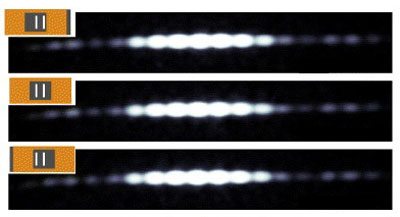
Physicists in the US and Canada say that they have done the best job yet of realizing Richard Feynman’s famous thought experiment about how single electrons pass through two slits. Although the researchers are not the first to recreate the experiment in the lab, they say that their incarnation best captures the essence of the original exercise.
Feynman originally outlined his thought experiment in volume three of his famous series The Feynman Lectures on Physics as a way of illustrating wave–particle duality in quantum mechanics. In the book, he invites the reader to imagine firing individual electrons through two slits and then marking the position where each electron strikes a screen behind the slits.
After many electrons have passed through the slits, the marks on the screen will comprise a diffraction pattern – illustrating the wave-like behaviour of each electron. But if one were to cover up one of the slits so that each electron could only pass through the other slit, the diffraction pattern would not appear – showing that each electron does indeed travel through both slits.
Potted history
When the third volume of The Feynman Lectures on Physics was published in 1965, physicists already knew that firing a beam of electrons at a double slit results in a diffraction pattern because the experiment had been performed in 1961 by Claus Jönsson at the University of Tübingen in Germany. But while Jönsson’s work clearly illustrated that a beam of electrons can behave as a wave, it did not establish a crucial point of Feynman’s experiment – that an individual electron itself can behave like a wave.
Single-electron double-slit diffraction was first demonstrated in 1974 by Giulio Pozzi and colleagues at the University of Bologna in Italy, who passed single electrons through a biprism – an electron optical device that serves the same function as a double slit – and observed the build-up of a diffraction pattern. A similar experiment was also carried out in 1989 by Akira Tonomura and colleagues at Hitachi’s research lab in Japan.
The first single-electron experiment to use an actual double slit was reported in 2008 by Pozzi and colleagues. The Italian team also conducted the experiment with one slit plugged, which – as expected – did not lead to the creation of a double-slit diffraction pattern. The team also performed another experiment in 2012, in which the arrivals of individual electrons from a double slit were recorded one at a time.
True to Feynman’s methodology
Herman Batelaan of the University of Nebraska-Lincoln, together with colleagues there and at the Perimeter Institute for Theoretical Physics in Waterloo, Canada, now say that they have created a double-slit experiment that follows the precise methodology of Feynman’s thought experiment.
The work originally began as an undergraduate research project at Nebraska and gained momentum when the Perimeter’s Damian Pope found out that Batelaan and colleagues were working on a realization of the experiment. Pope, who is involved in outreach work at Perimeter, had been keen on making a film about the thought experiment.
The team created a double slit in a gold-coated silicon membrane, in which each slit is 62 nm wide and 4 μm long with a slit separation of 272 nm. To block one slit at a time, a tiny mask controlled by a piezoelectric actuator was slide back and forth across the double slits.
The electrons were created at a tungsten filament and accelerated across 600 V and collimated into a beam. After passing through the double slit, they were detected using a multichannel plate.
One electron per second
The intensity of the electron source was set so low that only about one electron per second was detected – which ensured that only one electron at a time would ever pass through the slits. At this rate it took about two hours for a pattern to build up on the detector – a process that was recorded in real time (see video below). Measurements were repeated with the mask in a series of positions: first blocking both slits, then one slit, then none and then the opposite slit. As expected, the double-slit pattern was seen when the electrons had access to both slits, but not seen when one slit was blocked.
Batelaan told physicsworld.com that the experiment is particularly important from an outreach perspective because unlike the biprism experiments of the past, it actually uses a physical double slit and is therefore more accessible to the public. Young’s double-slit experiment with single electrons was voted the “most beautiful experiment in physics” by Physics World readers in 2002.
The experiment is described in the New Journal of Physics.
- To read more about the quantum world, you can download a free PDF of the March 2013 special issue of Physics World on quantum physics via this link.



